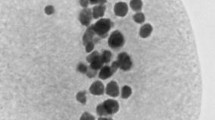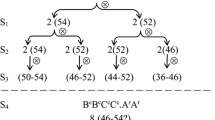Abstract
In a previous study we proposed that cytoplasmic genomes have played an important role in the evolution of Brassica amphidiploid species. Based on this and other studies, we hypothesized that interactions between the maternal cytoplasmic genomes and the paternal nuclear genome may cause alterations in genome structure and/or gene expression of a newly synthesized amphidiploid, which may play an important role in the evolution of natural amphidiploid species. To test this hypothesis, a series of synthetic amphidiploids, including all three analogs of the natural amphidiploids B. napus, B. juncea, and B. Carinata and their reciprocal forms, were developed. These synthetic amphidiploids were characterized for morphological traits, chromosome number, and RFLPs revealed by chloroplast, mitochondrial, and nuclear DNA clones. The maternal transmission of chloroplast and mitochondrial genomes was observed in all of the F1 hybrids examined except one hybrid plant derived from the B. rapa x B. oleracea combination, which showed a biparental transmission of organelles. However, the paternal chloroplast and mitochondrial genomes were not observed in the F2 progeny. Nuclear genomes of synthetic amphidiploids had combined RFLP patterns of their parental species for all of the nuclear DNA clones examined. A variation in fertility was observed among self-pollinated progenies of single amphidiploids that had completely homozygous genome constitutions. Comparisons between natural and synthetic amphidiploids based on restriction fragment length polymorphism (RFLP) patterns indicated that natural amphidiploids are considerably more distant from the progenitor diploid species than the synthetic amphidiploids. The utility of these synthetic amphidiploids for investigating the evolution of amphidiploidy is discussed.
Similar content being viewed by others
References
Bajaj YPS, Mahajan SK, Labana KS (1986) Interspecific hybridization of Brassica napus and B. Juncea through ovary, ovule and embryo culture. Euphytica 35:103–109
Burke TJ, Callis J, Vierstra RD (1988) Characterization of a polyubiquitin genes from Arabidopsis thaliana. Mol Gen Genet 213:435–443
Chase MW, Palmer JD (1989) Chloroplast DNA systematics of liliod monocots: resources, feasibility, and an example from the Orchidaceae. Am J Bot 76:1720–1730
Chen BY, Heneen WK, Simonson V (1989) Comparative and genetic studies of isozymes in resynthesized and cultivated Brassica napus L., B. Campestris L. and B. alboglabra Bailey. Theor Appl Genet 77:673–679
Coulthart M, Denford KE (1982) Isozyme studies in Brassica. I. Electrophoresis techniques for leaf enzymes and comparison of B. napus, B. campestris and B. Oleracea using phosphoglucoisomerase. Can J Plant Sci 62:621–630
Crouch ML, Tenbarge KM, Simon AE, Ferl R (1983) cDNA clones for Brassica napus seed storage proteins: evidence from nucleotide sequence analysis that both subunits of napin are cleaved from a precursor polypeptide. J Mol Appl Genet 2:273–283
Demaggio AE, Lambrukos J (1974) Polyploidy and gene dosage effects on peroxidase activity in ferns. Biochem Genet 12:429–440
Edwardson J (1970) Cytoplasmic male sterility. Bot Rev 36:341–420
Erickson L, Kemble R (1990) Paternal inheritance of mitochondria in rapeseed (Brassica napus). Mol Gen Genet 222:135–139
Erickson L, Grant I, Beversdorf W (1986) Cytoplasmic male sterility in rapeseed (Brassica napus L.). 1. Restriction patterns of chloroplast and mitochondrial DNA. Theor Appl Genet 72:145–150
Erickson LR, Straus NA, Beversdorf WD (1983) Restriction patterns reveal origins of chloroplast genomes in Brassica amphidiploids. Theor Appl Genet 65:201–206
Escote-Carlson LJ, Gabay-Laughnan S, Laughnan JO (1982) Nucleo-cytoplasmic interaction in cms-S of maize. In: Sheridan WF (ed) Maize for biological research. Plant Mol Biol Assoc, Charlottesville, N.C., pp 243–245
Escote-Carlson LJ, Gabay-Laughnan S, Laughnan JO (1990) Nuclear genotype affects mitochondrial genome organization of cms-S maize. Mol Gen Genet 223:457–464
Gastony GJ (1991) Gene silencing in a polyploid homosporous fern: paleopolyploidy revisited. Proc Nalt Acad Sci USA 88:1602–1605
Harper JF, Surowy TK, Sussman MR (1989) Molecular cloning and sequence of cDNA encoding the plasma membrane proton pump (H+ATPase) of Arabidopsis thaliana. Proc Natl Acad Sci USA 86:1234–1238
Kata M, Tokumasu S (1978) Nucleus substitution of Brassica with Raphanus. Cruciferae Newsl 3:42
MacKenzie SA, Pring SR, Bassett MJ, Chase CD (1988) Mitochondrial DNA rearrangement associated with fertility restoration and cytoplasmic reversion to fertility in cytoplasmic male sterile Phaseolus vulgaris L. Proc Natl Acad Sci USA 85:2714–2717
Olsson G (1960a) Species crosses within the genus Brassica. I. Artificial Brassica juncea Coss. Hereditas 46:171–223
Olsson G (1960b) Species crosses within the genus Brassica. II. Artificial synthesis of Brassica napus L. Hereditas 46:351–386
Palmer JD, Shield CR (1984) Tripartite structure of the Brassica Campestris mitochondrial genome. Nature 307:437–440
Palmer JD, Shield CR, Cohen DB, Orton TJ (1983) Chloroplast DNA evolution and the origin of amphidiploid Brassica species. Theor Appl Genet 65:181–189
Pearson OH (1981) Nature and mechanisms of cytoplasmic male sterility in higher plants. HortiScience 16:482–487
Polans NO, Weeden NF, Thompson WF (1986) Distribution, inheritance and linkage relationships of ribosomal DNA spacer length variants in pea. Theor Appl Genet 72:289–295
Prakash S, Hinata K (1980) Taxonomy, cytogenetics and origin of crop Brassica, a review. Opera Bot 55:1–57
Quiros CF, Ochoa O, Douches DS (1988) Exploring the role of x = 7 species in Brassica evolution: Hybridization with B. Nigra and B. Oleracea. J Hered 79:351–358
Riley R, Chapman V (1958) Genetic control of the cytologically diploid behaviour of hexaploid wheat. Nature 182:713–715
Roose ML, Gottlieb LD (1976) Genetic and biochemical consequences of polyploidy in Tragopogen. Evolution 30:818–830
Sears ER (1976) Genetic control of chromosome pairing in wheat. Annu Rev Genet 10:31–51
Shiga T (1980) Male sterility and cytoplasmic differentiation. In: Tsunoda S, Hinata K, Gomez-Campo C (eds) Brassica crops and wild allies. Jpn Sci Sco Press, Tokyo, pp 205–221
Simon AE, Tenbarge KM, Scofield SR, Finkelstein RR, Crouch ML (1985) Nucleotide sequence of a cDNA clone of Brassica Napus 12 S storage protein shows homology with legumin from Pisum sativum. Plant Mol Bio 5:191–201
Song KM, Osborn TC (1992) Polyphyletic origins of Brassica Napus: new evidence based on organelle and nuclear RFLP analyses. Genome 35:992–1001
Song KM, Osborn TC, Williams PH (1988) Brassica taxonomy based on nuclear restriction fragment length polymorphisms (RFLPs) I. Genome evolution of diploid and amphidiploid species. Theor Appl Genet 75:784–794
Song KM, Suzuki JY, Slocum MK, Williams PH, Osborn TC (1991) A linkage map of Brassica rapa (syn. campestris) based on nuclear restriction fragment length polymorphism loci. Theor Appl Genet 82:296–304
UN (1935) Genomic analysis in Brassica with special reference to the experimental formation of B. Napus and peculiar mode of fertilization. Jpn J Bot 7:389–452
Williams JGK, Kubelik AR, Livak KJ, Rafalski JA, Tingey SV (1990) DNA polymorphisms amplified by arbitrary primers are useful as genetic markers. Nucleic Acids Res 18:6531–6535
Wilson HD, Barber SC, Walters T (1983) Loss of duplicate gene expression in tetraploid Chenopodium. Biochem Systems Ecol 11:7–13
Author information
Authors and Affiliations
Additional information
Communicated by G. E. Hart
Rights and permissions
About this article
Cite this article
Song, K., Tang, K. & Osborn, T.C. Development of synthetic Brassica amphidiploids by reciprocal hybridization and comparison to natural amphidiploids. Theoret. Appl. Genetics 86, 811–821 (1993). https://doi.org/10.1007/BF00212606
Received:
Accepted:
Issue Date:
DOI: https://doi.org/10.1007/BF00212606




